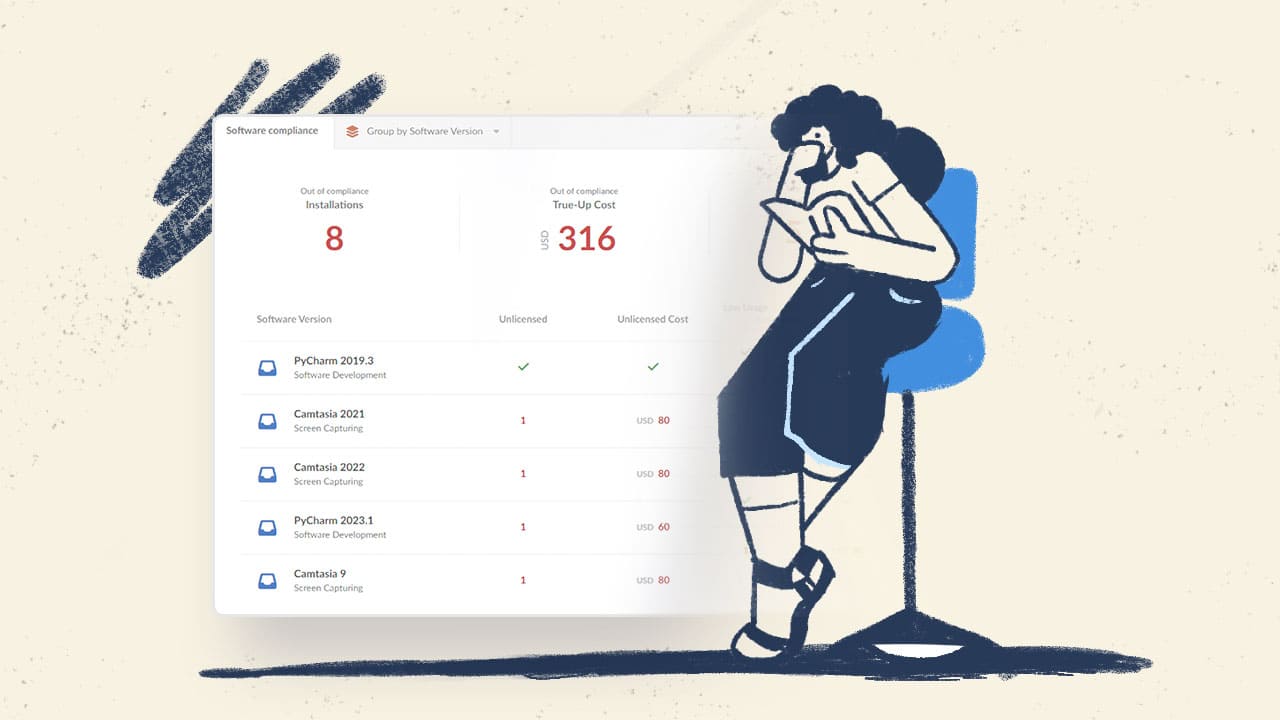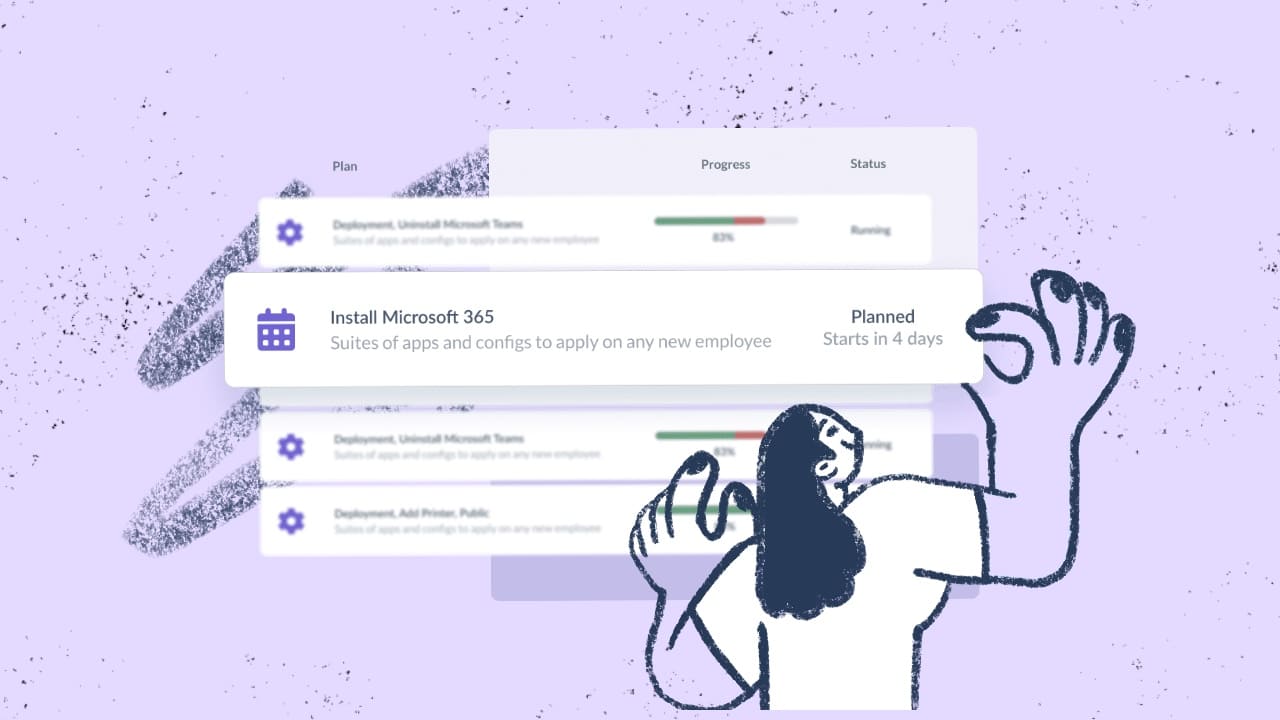Let’s talk about something every IT team faces: patching. It’s essential for security but can quickly turn into a time-consuming and stressful task. That’s where automated Patch Management comes to the rescue, taking the hassle out of the process and ensuring vulnerabilities are fixed faster than ever.
Here’s the kicker: according to Adaptiva’s State of Patch Management in the Digital Workplace report, 77% of organizations take more than two weeks to deploy patches. That’s two weeks of risk your systems just don’t need. With automation, you can streamline patching, cut down deployment times, and free your team to focus on bigger priorities.
In this post, we’ll break down everything you need to know about automated Patch Management—why it matters, how it works, and how to make it work for you. Ready to turn patching from a headache into a breeze? Let’s get started!

What is automated Patch Management?
Before diving into automated patching, let’s quickly cover the basics. Patch Management is the process of identifying, acquiring, testing, and deploying software updates—or patches—to fix vulnerabilities, improve performance, or add features. It’s an essential part of IT Asset Management and cybersecurity, keeping systems secure and running smoothly.
Automated Patch Management takes this process to the next level by using software tools to handle patching automatically, from start to finish. Instead of relying on manual steps (which can be time-consuming and prone to error), automation ensures patches are applied efficiently and consistently across all systems.
The result? Reduced downtime, fewer security risks, and a lot less stress for your IT team. Automated Patch Management not only saves time but also helps organizations stay compliant with security regulations and minimize exposure to cyber threats.
Automated vs. manual Patch Management
When it comes to managing patches, there are two main approaches: manual patching and automated patching. Both aim to address software vulnerabilities and keep systems secure, but how they get the job done—and the results they deliver—are vastly different.
Manual Patch Management involves a series of hands-on tasks. IT teams must identify missing patches, download them, test their compatibility, and deploy them across systems—often one by one. While this approach gives full control over the process, it’s time-consuming, labor-intensive, and highly prone to human error. Missed updates, misconfigurations, and delays can leave your organization exposed to security threats.
On the other hand, automated Patch Management is like putting your patching process on autopilot. Automated tools handle everything from detecting vulnerabilities to testing and deploying patches across all devices, ensuring consistent and timely updates. It’s faster, more reliable, and eliminates the risks that come with manual intervention.
Benefits of automating Patch Management
We already know that patching systems manually is not only a tedious process, but it also leaves room for delays, errors, and security vulnerabilities. Drawing on key insights from Doug Rabold, Senior Manager of Customer Support at Amwell and Chairman of the Board at HDI, as shared in episode 43 of Ticket Volume - IT Podcast, automating the entire Patch Management process transforms it from a daunting task into an efficient, streamlined operation.
Here are the main benefits of automated Patch Management:
1. Improved security posture
Unpatched vulnerabilities are one of the leading causes of data breaches. Automated patching tools ensure security updates are applied quickly and consistently across all systems, minimizing exposure to malware and cyber threats. With automation, your IT environment stays protected against the latest security risks, from critical vulnerabilities to zero-day exploits.
|
|
"By removing repetitive issues that automation can solve, teams can focus on resolving critical vulnerabilities and improving overall customer satisfaction." Doug Rabold |
2. Faster patch deployments
Timing is critical in patching processes. The longer systems remain unpatched, the higher the risk of exploitation. Automated Patch Management tools allow you to automatically identify, test, and deploy patches, ensuring updates are applied promptly to address critical vulnerabilities and fix security vulnerabilities before they can be exploited.
3. Simplified compliance and reporting
Staying compliant with security regulations is a top priority for most organizations. Automated patching methods help you maintain patch compliance by keeping all systems up to date. These tools also provide detailed reports on patch deployment status, making it easier to demonstrate compliance during audits or regulatory reviews.

4. Consistency across the IT environment
Automation ensures that patches are deployed uniformly across various operating systems, third-party applications, and remote devices. This eliminates discrepancies, reduces manual processes, and ensures that no device is left behind during patch deployments.
5. Reduced risk of human error
With manual patching, it’s easy for mistakes to slip through—whether it’s forgetting to apply an update or deploying the wrong version of a patch. Automating the entire Patch Management process minimizes the potential for human error, ensuring a more reliable and effective patching process.
6. Time and resource efficiency
Manual patching is labor-intensive, requiring IT teams to manually identify, test, and deploy patches. Automating this process frees up valuable time and resources, allowing your team to focus on strategic initiatives rather than mundane tasks. Automated solutions can also handle remote endpoints and third-party applications, ensuring patch deployment is seamless even in complex environments.
|
|
"Automation isn’t a threat; it’s an opportunity. It allows you to skill up your staff to handle more complex tasks that automation can’t address." Doug Rabold |
How to automate the Patch Management process
Transitioning from manual patching to automation can feel like a big leap, but with the right approach, it’s a straightforward process that will pay off in the long run. Automating your Patch Management process not only improves efficiency but also ensures your systems remain secure, compliant, and up to date.
Here’s a step-by-step guide to help you get started:
- Assess your current Patch Management practices.
- Choose the right automated Patch Management solution.
- Create a comprehensive Patch Management policy.
- Set up patch testing and validation procedures.
- Implement automated patch deployment.
- Monitor and report on patch deployment status.
- Review and optimize the process regularly.
1. Assess your current Patch Management practices
Before diving into automation, it’s important to evaluate your existing Patch Management process. This step helps identify gaps, inefficiencies, and areas that would benefit the most from automation. Here’s how to perform this assessment:
- Inventory your systems: Create a complete inventory of your IT environment, including operating systems, applications, and devices (both on-premises and remote endpoints).
- Identify unpatched systems: Use tools or audits to determine systems with missing patches or unpatched vulnerabilities.
- Map out your current workflow: Document the manual steps your team follows, from identifying vulnerabilities to deploying patches.
- Evaluate past performance: Review patch deployment timelines, successfully tested patches, and past security incidents caused by delays or errors.
- Pinpoint bottlenecks: Identify the specific steps causing delays, such as manual testing or bandwidth issues.
This assessment sets the foundation for building an automated Patch Management process tailored to your organization’s needs. Once you have a clear picture of your current practices, you’ll be ready to move on to the next step: choosing the right tool for the job.
2. Choose the right automated Patch Management tool
Selecting the best tool for your organization is a critical step in automating the Patch Management process. There are many dedicated Patch Management tools available that are specifically designed to streamline this process, and we’ll be focusing on those in this section. However, you also have the option to choose an ITAM tool with many Patch Management capabilities, such as InvGate Asset Management.
Whether you’re just starting to explore your options or narrowing down your choices, understanding the key aspects of a Patch Management solution is essential. We’ve also covered some of the top Patch Management tools in a dedicated blog post to help you make an informed decision. For now, let’s break down what to look for in detail:
Comprehensive coverage
An effective Patch Management solution must support a wide range of operating systems, third-party applications, and devices. This includes ensuring compatibility with Windows, macOS, Linux, and any specialized systems your organization relies on.
It should also manage updates for both first-party and third-party applications, such as browsers, productivity suites, and security tools. Additionally, the tool should handle patching across all endpoints, including on-premises, cloud-based, and remote devices. Comprehensive coverage eliminates the need for multiple tools and simplifies the patching process.
Automation capabilities
The best automated Patch Management tool should handle every step of the patching lifecycle. From automatic detection of missing patches to testing and deployment, automation capabilities are key. Look for features that include automated patch discovery to scan for vulnerabilities, as well as tools for testing patches in a controlled environment to minimize deployment risks.
The ability to schedule and deploy updates automatically is essential for consistency, while support for emergency patches ensures quick response to critical security vulnerabilities. Automation makes patching faster, more reliable, and far less error-prone.
Scalability
Your chosen tool should grow with your organization. It must be capable of managing a large number of endpoints, whether you’re handling a few dozen devices or thousands. The ability to support remote endpoints is especially important in today’s hybrid and remote work environments.
As your infrastructure expands, the tool should maintain its efficiency and performance without any hiccups. Scalability ensures that your Patch Management software remains effective no matter how complex your IT environment becomes.
Compliance features
Staying compliant with industry regulations is a priority for most organizations. An ideal solution provides patch compliance tracking, generating detailed reports that demonstrate regulatory adherence during audits. Automated reporting tools save time by delivering clear insights into patch deployment status and system security.
Additionally, the tool should align with frameworks like GDPR, HIPAA, or PCI DSS to meet your specific compliance requirements. Robust compliance features ensure your organization avoids penalties while maintaining a secure IT environment.

Customization options
No two IT environments are the same, so flexibility is critical. The tool should allow you to customize patch schedules, ensuring updates are applied during non-disruptive hours. It should also enable prioritization of critical patches to address high-risk vulnerabilities first.
Granular control over patching processes is essential, letting you tailor updates for specific devices, departments, or risk levels. Customization ensures the automated patching process aligns perfectly with your organization’s needs.
User-friendly interface
An intuitive and user-friendly interface simplifies the Patch Management process for your IT team. The tool should provide clear dashboards that display real-time information on patch deployment status, compliance, and system health.
A streamlined design ensures tasks are executed quickly without steep learning curves. Alerts and notifications should keep the team informed of progress or any issues, enabling faster response times. A user-friendly interface increases efficiency and minimizes the complexity of managing patches.
Vendor reputation
Finally, select a tool from a reputable vendor with a proven track record. Look for industry reviews and customer feedback to ensure the tool performs reliably. Strong customer support is vital, offering guidance during setup and troubleshooting.
Established solutions are often safer bets due to their history of addressing industry-specific needs. A trusted vendor ensures you’re investing in a dependable and long-term Patch Management solution.
3. Create a comprehensive Patch Management policy
A clear and detailed Patch Management policy is the backbone of an effective automated patching strategy. This document serves as a blueprint for how patches are identified, tested, approved, and deployed across your organization.
Start by defining roles and responsibilities—who oversees the process, manages exceptions, and ensures compliance. Outline the patching process, including timelines for addressing vulnerabilities based on severity, such as immediate deployment for critical vulnerabilities or regular updates for less urgent fixes.
Your policy should also address how patches for third-party applications and operating systems will be handled, as well as processes for testing patches in a controlled environment. By setting expectations and providing clear guidelines, you create a standardized framework that makes leveraging automated patching methods more effective and aligned with your organization’s security goals.
4. Set up patch testing and validation procedures
Even with automation, testing patches before deployment is a critical step to ensure stability and compatibility. Automated tools often include features to test updates in a controlled environment, such as a sandbox or lab setup. Use this phase to check for potential issues with business-critical applications or systems.
Establish validation procedures to confirm that tested patches don’t cause disruptions or introduce new vulnerabilities. Document the results and use them to adjust deployment schedules or identify systems that may require additional preparation. Automated testing saves time and ensures that patches are successfully tested and ready for production deployment.
5. Implement automated patch deployment
This is where automation truly shines. Use your chosen tool to schedule and execute patch deployments across your systems. Prioritize critical updates and set up a patch deployment schedule that minimizes disruption, such as during non-business hours.
Automated tools allow you to define deployment rules for specific device groups, departments, or risk levels. They can also ensure that emergency patches are deployed quickly when needed. By automating this phase, you can ensure consistent and efficient patching across your entire IT environment, reducing the risk of unpatched systems and security vulnerabilities.

6. Monitor and report on patch deployment status
After deployment, it’s essential to monitor the process and verify that patches have been successfully applied. Automated tools provide dashboards and reports that offer real-time visibility into the patch deployment status for each device or system.
Look for any failed deployments or systems that were missed, and address them immediately to maintain patch compliance. Reporting features can also help demonstrate compliance with regulatory requirements, providing evidence of your organization’s commitment to cybersecurity. Continuous monitoring ensures that the automated Patch Management process runs smoothly and effectively.
7. Review and optimize the process regularly
Automation doesn’t mean you can set it and forget it. Regular reviews of your automated patching process help identify areas for improvement. Analyze performance metrics, such as deployment timelines, compliance rates, and incidents of failed patches, to pinpoint bottlenecks or inefficiencies.
Adjust your policy, tool configurations, or schedules based on feedback from IT teams and audit reports. By continually refining the process, you ensure your Patch Management remains effective, efficient, and aligned with evolving cybersecurity threats and organizational needs.

Patch Management best practices
To ensure your Patch Management process is as effective and streamlined as possible, follow these best practices. We’ve summarized the essential steps here, but for more details and in-depth guidance, be sure to check out our full blog post on Patch Management best practices.
1. Maintain a complete asset inventory
Keeping an up-to-date inventory of all your IT assets—hardware, operating systems, and applications—is crucial. This allows you to track which devices need updates and ensures no system is overlooked during patch deployments. Regularly review and update your inventory to include new devices and software as they’re added to your network.
2. Prioritize patches based on risk
Not all patches are created equal. Focus on critical updates that address vulnerabilities actively exploited by cybercriminals or that significantly impact system performance. Use your Patch Management tool to categorize and prioritize patches, addressing high-risk vulnerabilities first to reduce security risks effectively.
3. Test patches in a controlled environment
Testing patches before deploying them to production systems helps ensure compatibility and stability. Use a lab or sandbox environment to validate updates, identifying potential conflicts with business-critical applications. This step reduces the likelihood of downtime or disruptions caused by poorly tested updates.
4. Schedule regular patch deployment cycles
Consistency is key. Create a patch deployment schedule that aligns with your organization’s needs, ensuring updates are applied regularly without interrupting daily operations. For critical vulnerabilities, set up processes to handle emergency patches promptly.
5. Monitor patch deployment and track progress
Use your automated tool’s reporting features to monitor patch deployment status and track progress. Identify any failed deployments or missed systems, and take corrective actions immediately. Monitoring ensures all systems stay updated and compliant with your security policies.
6. Educate your team and end users
Human error can still play a role in the patching process. Provide training for your IT teams on using the automated tool effectively and educate end users on recognizing security vulnerabilities and the importance of updates. A well-informed workforce is a valuable asset in maintaining a secure environment.
7. Regularly review and update your process
Cybersecurity threats evolve, and so should your patching process. Regularly review your strategy, policies, and tool configurations to ensure they remain effective. Adjust to new vulnerabilities, compliance requirements, and organizational changes to keep your systems secure.
Conclusion: transform Patch Management with automation
Automating your Patch Management process is a game-changer for organizations looking to enhance security and streamline operations. By leveraging the right tools and following best practices, you can eliminate the inefficiencies and risks of manual patching, ensuring your systems are updated consistently and promptly.
With faster deployments, improved compliance, and fewer vulnerabilities, automated Patch Management not only protects your organization but also frees your IT team to focus on more strategic initiatives. It’s time to move beyond the challenges of manual patching and embrace a solution that keeps your IT environment secure and efficient.















